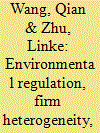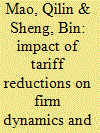| Srl | Item |
| 1 |
ID:
182768


|
|
|
|
|
| Summary/Abstract |
We describe a model with firm heterogeneity and endogenous pollution abatement to show how emission intensity and exit/entry selections vary across firms. Using Chinese firm-level emission and production data, we find evidence that low productivity firms have higher emission intensity. The emission intensity of firms with productivity below 10 percentile is 5.26 times larger than firms with productivity above 90 percentile. Combining the Annual Survey of Chinese Industrial Enterprises (CIE) data, and applying a triple-difference research design, we find that firms with high emission intensity or low productivity have a higher probability of exit when exposed to strict environmental policy. We also find the exit of unproductive firms contributes to aggregate productivity and strict environmental policy can help to reduce misallocation.
|
|
|
|
|
|
|
|
|
|
|
|
|
|
|
|
| 2 |
ID:
188156


|
|
|
|
|
| Summary/Abstract |
We explore firm quasi-dynamics (entry, exit, and growth) in Chinese manufacturing industry and investigate how these dynamics vary across regions. Our results show that relative to provinces with less developed economies, in provinces with more developed economies (i) there is a higher proportion of new firms; (ii) new firms are smaller and more labor-intensive; (iii) firms exit at a quicker rate, and surviving firms grow faster. These results point toward cross-region differences in market efficiency in terms of how much it costs a firm to enter or exit the market. Our findings shed light on how firms should adapt their strategies across regions and how the government should create sound policies on industrial upgrading and relocation.
|
|
|
|
|
|
|
|
|
|
|
|
|
|
|
|
| 3 |
ID:
156465


|
|
|
|
|
| Summary/Abstract |
This paper investigates the impact of trade liberalization on firm dynamics and productivity in the context of dramatic tariff reductions after China's accession to the WTO, and how this impact varies across regions with different marketization levels. Our results show that (a) on average, output tariff reductions tend to reduce firm entry rate and increase firm exit rate, while input tariff reductions help to increase both firm entry rate and exit rate, furthermore, regional marketization strengthens the impact of trade liberalization on firm dynamics; (b) trade liberalization exerts greater impact on the likelihood of exit for the least productive firms while it tends to reduce the probability of exit for the more productive firms, with regional marketization strengthening such a reallocation process of trade liberalization; (c) firm dynamics effect contributes approximately 43% of the growth of productivity, and it (especially the firm exit effect) is an important channel through which trade liberalization fosters productivity growth, and domestic market reform is found to strengthen such an impact.
|
|
|
|
|
|
|
|
|
|
|
|
|
|
|
|